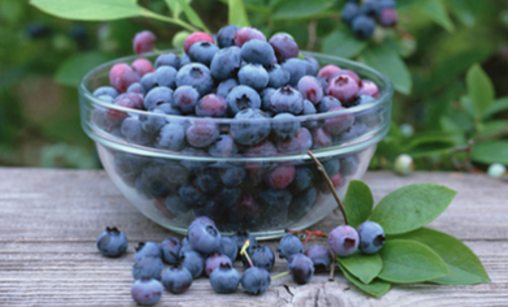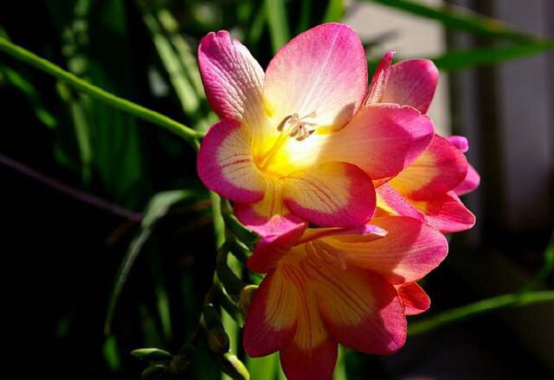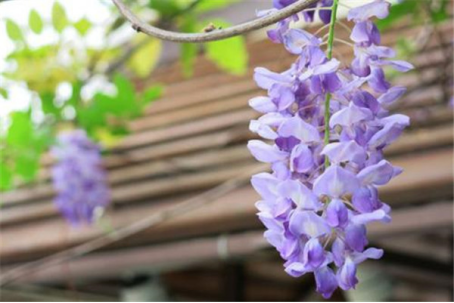Will you die if you eat 250g blueberries at a time?
The editor solemnly tells you that eating 250g blueberries at a time will not kill you! Usually what we buy in the supermarket is a box of blueberries, a box of about 125g, many people love to eat blueberries, unwittingly eat a whole box of blueberries, although will not die, but may cause some uncomfortable symptoms. After all, blueberries are cold, so it's not as good as too much.

Brief introduction of blueberry planting method blueberry planting method blueberry picture
Blueberry, also known as blueberry, Benedictine, persimmon, Duyu, persimmon, Dianguo, Benedictine blueberry, narrowly refers to a group of flowering plants of the subgenus blueberry subgenus Cyanococcus (scientific name: blueberry). In a broad sense, it can include all species of blueberry with blue berries. Native to North America and East Asia, these species are shrubs ranging in height from 10 cm to 4 m; dwarf species are called lowbush blueberries and tall species are called highbush blueberries. Leaves can be deciduous or evergreen, ovoid to lanceolate, 1 to 8 cm long and 0.5 to 3.5 cm wide. The flowers are bell-shaped, with colors ranging from white to peach to red, sometimes with a hint of green. The fruit is botanically false, 5 to 16 mm in diameter, with a trumpet-shaped crown at the end; at first light green, then reddish purple, and finally blue or dark purple, which can be harvested when ripe. It has a sweet flavor when it is ripe, but the acidity varies. Other subgenera of the genus blueberry, including other wild shrubs with edible berries, such as cranberries, mulberry, and blueberries. Blueberries are produced every year from May to October, peaking in July. Vaccinium uliginosum, also known as persimmon and Benedictine, is often called blueberry in northern China.
Blueberry, the most popular super fruit in recent years, is the only fruit selected among the top 10 healthy foods such as green tea announced by the World Health Organization. The Food and Agriculture Organization of the United Nations also lists blueberries as one of the five healthier foods for human beings. According to time magazine, "blueberries may contain more antioxidants than any other fruit or vegetable."
With the development of society, the improvement of life and the richness of leisure life, it has become a fashion to raise flowers and grass by yourself. And a large number of people in the balcony, balcony planted small fruit trees, blueberries, can be regarded as a choice, in addition to eating, small and exquisite fruit ornamental value is also high.
Blueberries are mainly in the north, south, half-height, dwarf and rabbit-eyed blueberries in China
South Gaocong: small cold storage, large fruit, good taste, suitable for the Yangtze River basin and the south
North high cluster, semi-high cluster: large cooling capacity, large fruit, good taste, suitable for the north of the Yangtze River Basin
Dwarf bushes: small fruit, easy maintenance, strong cold resistance, suitable for high and cold areas
Rabbit eye: the tree is tall, resistant to moisture and heat, and has high yield, which is suitable for the south of the Yangtze River Basin and South China.
Several conditions for blueberry cultivation:
1. Soil PH: blueberry can grow healthily in acidic medium, and the pH of cultivated soil is between 4.5 and 5.5, which is the most suitable for blueberry growth. The pH value of garden soil is generally between 6 and 7, and the lowest pH value of acidic soil sold in flower and bird market is between 5.5 and 6. The general planting base uses sulfur powder to adjust acid, and adding one gram of sulfur powder per liter of soil can reduce the soil PH value by 1. There are also individual varieties, which do not require much acidity, but they are not as good as those planted in acidic soil.
two。 Cold storage capacity: the so-called cold storage capacity means that blueberries generally need a low temperature of less than 7.2 ℃ for normal flowering and fruiting. Blueberry varieties are classified mainly on the basis of cold storage. If the cold storage capacity is not enough, even if it blossoms, it will not bear fruit. (PS: in the above classification, the suitable areas are for reference only. For example, many places in the high mountains of the south are also suitable for the cultivation of blueberries in the north alpine bushes. )
3. Fertilizer: blueberries disrelish fat and calcium, in planting, generally add rotten cattle, sheep, rabbit dung or rotten leaf soil at the beginning of planting, disrelish fat but not top dressing, so in the future planting, a small amount of topdressing is still necessary. Don't get fat! Nitrogen, phosphorus and potassium compound fertilizer with a content of 1:1:1, or ammonium sulfate solution of 2000 times is generally used. Also pay attention to stay away from things that contain calcium, such as some people often put eggshells in flowerpots.
4. Watering: blueberries like to be wet, but they need loose and breathable soil, so the soil must be permeable and breathable. When the temperature is high and hot, it may need to be watered in the morning and evening. After I tried planting Beigao to my friends in Guangdong, I found that proper watering can make blueberries resist high temperature and spend the summer safely.
5. Lighting: the demand for light of blueberry is the same as that of other plants; in contrast, if the light intensity of the same variety is not enough, it will produce fewer flower buds and lower fruit quality. For orchards with high cultivation density, proper pruning is conducive to photosynthesis. For the balcony terrace family, the light management of blueberries is simpler than that of the orchard, but should pay attention to ventilation. It is recommended that the south balcony should be placed.
6. Pollination: the pollination of blueberries is very important. Blueberries are mostly cross-pollinated. High-clump blueberries can self-flower and bear fruit, while rabbit-eyed blueberries and dwarf blueberries generally need to be equipped with pollination trees. Because of the structural characteristics of blueberry floral organ and high pollen viscosity, pollination is mainly completed by insects. It is generally believed that the wings of bumblebees vibrate and can shake out pollen, and for species with a deep Corolla, bees are not easy to collect pollination, so plantations mainly rely on bumblebee pollination. Artificial pollination can be gently dipped in pollen with a brush; some friends pollinate with a hair dryer, and the effect is very good, so it can be seen that enough wind can also play a good role in pollination.
7. Cold protection: dwarf bushes and semi-tall bushes have strong cold resistance, but due to different low temperatures in different places, freezing damage still occurs in extreme weather, the most important of which is frost injury at the ends of branches and flower buds overwintering in the open air, or even the whole plant to death. Therefore, blueberry cultivation and overwintering protection are also important measures to increase yield in cold areas.
8. Potted plants: in more and more compact cities, blueberries are mainly potted, and almost all blueberries are suitable for potted plants. however, some blueberry varieties with large crown, high crown and scattered trees are not suitable for balcony clans. the balcony should also pay attention to choosing the right varieties of height to facilitate the movement of flowerpots.
Restate a few key points.
1. Blueberries like acid, away from alkaline things as far as possible, especially plant ash!
two。 Blueberries dislike calcium, the farther away from things containing calcium, such as: lime, eggshell!
3. Blueberries lack of acid, many people ask me, CCTV said to pour vinegar, I do not know where the expert advice, vinegar what do you know? Can you believe the data in the material ratio? Chinese people's anti-virus level is so high that it doesn't hurt or itch, but if blueberries don't get used to drinking, they will die to show you. Do you still have a dosage? did the experts tell you? Such as lack of acid, Amoy rice water, pineapple peel and other pericarp after fermentation, diluted with water to a PH value of 4-6, usage: once fermentation water at intervals of two times and then again fermentation water, at most twice a month fermentation water. Ferrous sulfate, although not recommended, can also quickly supplement acid and iron, the dosage (ferrous sulfate) 1 (water) 2000 times solution, usage is the same as above. Coconut
4. Bran, I don't know about other flowers and plants, but I would never recommend it on blueberries because it has too strong water retention capacity.
5. Pine needle soil, pine needle soil is not equal to pine needle, flower growers all know it.
The vitality of blueberries is still very strong. this spring, due to the blockage of sprinkler irrigation, more than a dozen plants were not watered. When it was found that the soil was completely dry, flowers, fruits and leaves fell, decisively soaked in water, and new buds sprouted ten days later.
How to grow blueberries
Blueberry is a kind of fruit that we are all familiar with, but in daily life, blueberry is a kind of fruit that we eat very little, and what we are more familiar with is blueberry jam. In fact, blueberries taste sour, sweet, delicious and nutritious, and they are a good kind of healthy fruit. So how are blueberries grown?
How to grow blueberries
1. To buy blueberry seedlings, it is best to choose the seedlings of 2-3 years. On the one hand, the seedlings are cheap, and on the other hand, they are adaptable and easy to grow.
2. If you plant blueberries in flowerpots, you'd better choose mud pots. The mud basin is breathable and cheap, but its disadvantage is that it is not very beautiful in black and gray. If you can't buy mud pots, you can choose pottery pots, followed by purple sand pots and plastic pots. Never use glazed porcelain pots. As for the size of the basin, 2-3 years of seedlings, choose a diameter of 25-30 cm basin on the line, avoid small seedlings and large pots. When you grow up, you will change the big basin. Of course, the bigger the mature plants of 4-5 years, the better.
3. Blueberry can grow healthily in acidic medium, and the PH value of cultivated soil is between 4 and 5, which is the most suitable for blueberry growth. This problem bothers many blueberry lovers, because the PH value of pastoral soil is generally between 6 and 7, and even the acidic soil sold in the flower and bird market has the lowest PH value between 5.5 and 6. After the blueberry seedlings are planted in the basin, they are kept indoors in the sun and ventilated for a week. This process is called slow seedling. After a week, you can move to the balcony for normal maintenance.
4. Blueberries like to get wet, especially in summer, they need enough water every day. But we should also be careful that there should be no stagnant water, otherwise the roots will rot. On a rainy day in Shanghai, blueberries don't have to go indoors, no matter how heavy the rain is, as long as the flowerpot is permeable. You can find that in the growing season, blueberry leaves are green and vibrant, and new leaves grow quickly when they are drenched in the rain for several days in a row.
5. Blueberries like the sun. They can't die in the sun at 40 degrees in summer. They can endure 40 ℃ ~ 50 ℃ temperatures in the surrounding environment during the growing season, as long as they are given enough water in the morning. Without enough sunlight, blueberries will stagnate and will not bear fruit even if they blossom.
6. Blueberries do not have a high demand for fertilizer, but fat will hurt it. There is a certain amount of rotten leaf soil in the medium, which can basically meet the growth needs of blueberries. Of course, if you want to eat your own blueberries, you still need the right amount of topdressing. It is recommended to use "Huaduoduo", 1 gram to 1000 grams of water, once every 7-10 days. This kind of fertilizer is so warm that it won't burn roots even if you use too much.
Plant blueberries in pots
1. Avoid the seedlings in a certain place and choose the varieties with good quality. We must distinguish between young seedlings. The key is to buy high-quality seedlings. I am afraid that they are fake seedlings, or those of poor quality that have been planted for a year but do not blossom or bear fruit, or inferior seedlings that bear only a few fruits.
2, but also to distinguish clearly, look at the picture of the seedling is not tall or three-year-old seedlings, but also to see whether the seedlings have been pruned, whether the growth of strong, you should also know a little bit of pruning techniques, ah, when pruning blueberry branches, pay attention to cut off the weak, sick and disabled branches, leaving long branches is better.
3. When growing blueberries, soil is the most important and crucial. Choose nutritious humus soil and soft and breathable organic soil. Don't choose soil that is too rigid. And usually when watering, do not water too often, the flowerpot should not be too humid.
4. The second is fertilization. It is recommended to use organic fertilizer when fertilizing, for example, chicken manure and rotten cake fertilizer. If it is compound fertilizer, use a few tablets at a time, not too close to the root, just put it on the edge of the flowerpot.
5. If it is a cold-resistant species, remember to spread something around the flowerpot or cover it with straw in winter. And can also be placed on the sunny balcony, Xiaobian where the central China region, directly on the open-air balcony, can also be smooth winter.
How to preserve blueberries
1. Water 3 to 5 cm a week. Be careful not to water too much.
2. Trim once every winter. In the first winter, cut off all the buds to make it more alive before it begins to bear fruit. It is also necessary to prune the branches that have stopped growing so that the fruiting part can grow better.
3. Every year after that, cut off the branches that grow too slowly and cut them from the sub-nodes. Also cut off all dead branches and twigs, as well as discolored and spotted parts.
4. For dwarf shrubs, prune all stems. The pruned plants will not bear fruit next season, so it is best to cut them in half at a time.
5. Pruning of branches can increase the growth rate from about 1 pound 3 to 1 pound 2. Try to cut off the collateral branches.
6. Fertilize blueberries. If your blueberry grows less than 30 centimeters a year (or, for dwarf shrubs, less than 10 centimeters), you can consider using natural fertilizer to speed up its growth. If possible, using organic fertilizer will not hurt the roots and provide the nitrogen needed for blueberries.
7. Harvest in late July or early August. For some species, including rabbit eyes, they mature later. The maturity time varies slightly with climate change each year.
The harvest of blueberries
The ripening period of blueberry fruits is different between Rabbit Eye and Nangao Cong. Generally, the harvest lasts for 20 to 30 days, usually once a week. The fruits should be picked manually when they are fresh, and can be harvested by machinery for processing. The diseases of blueberry are caused by fungal diseases, bacterial diseases and nematodes. China is a new introduction and cultivation area, and the occurrence of diseases and insect pests is less.
Blueberries taste unique, sweet taste with a hint of sour taste, especially delicious, is the favorite of many foodies. And blueberries can not only be eaten directly, but also can be made into a variety of delicious desserts and drinks. From this point of view, there are broad prospects for growing blueberries.
- Prev

What if the leaves of fragrant snow orchid turn yellow
The story takes place when the flower is still wild and has no name. One day, a Dutch lady saw the flower for the first time when she was hunting in South Africa, so she collected it herself and took it back. And the fragrant flowers were blown to the snow by the wind along the way.
- Next

Maintenance methods of wisteria bonsai:
1. Rather dry than wet watering basin soil watering pay attention to principles, watering too much, basin soil is too wet, but is not conducive to cultivation and flowering, especially in August flower bud differentiation period, should be appropriate to control the amount of watering, after defoliation should be less watering. two。 When pruning wisteria leaves buds in spring, pick appropriate amount to remove dense buds.
Related
- Fuxing push coffee new agricultural production and marketing class: lack of small-scale processing plants
- Jujube rice field leisure farm deep ploughing Yilan for five years to create a space for organic food and play
- Nongyu Farm-A trial of organic papaya for brave women with advanced technology
- Four points for attention in the prevention and control of diseases and insect pests of edible fungi
- How to add nutrient solution to Edible Fungi
- Is there any good way to control edible fungus mites?
- Open Inoculation Technology of Edible Fungi
- Is there any clever way to use fertilizer for edible fungus in winter?
- What agents are used to kill the pathogens of edible fungi in the mushroom shed?
- Rapid drying of Edible Fungi

